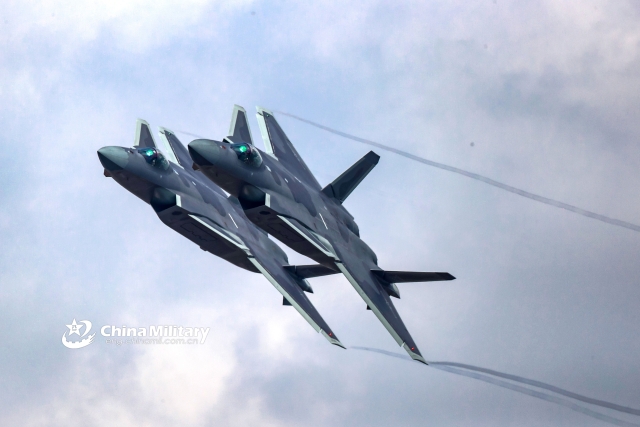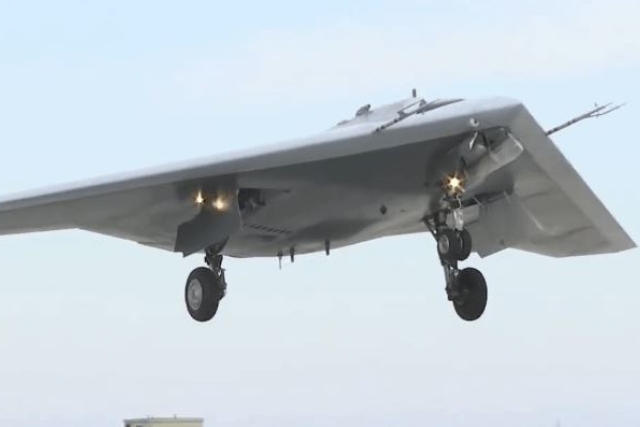Russian Su-57 and Chinese J-20 as Alternatives to the American F-35 Stealth Fighter
As American policy makes the F-35 unavailable to all but its closest allies, can the J-20 and Su-57 fill requirement for fifth generation fighter aircraft from the rest of the world?

Su-57 fighter
As the Russian Su-57 stealth fighter jet enters serial production, the debate over how it stacks up against the American F-35 has re-ignited. According to its manufacturer, the United Aircraft corporation (UAC), mass production process for the aircraft has already commenced and the first samples of serially-produced aircraft will roll out in early 2025.
The F-35 on the other hand is already well entrenched in Western markets with over a 1,000 aircraft flying or in production for the U.S. and its closest allies. Aside of most NATO countries, Israel, Japan, South Korea and Singapore are the lucky recipients of the F-35. For the rest of the world, Uncle Sam waves the “Not for Sale” flag.
Indonesia, the U.A.E. and Saudi Arabia which have expressed an interest in acquiring the F-35, have been told to buy the F-16 or F-15 fighter jets instead. Though India has not sought the F-35 as yet, its sale to New Delhi has been ruled with a top U.S. Navy official instead suggesting the F-16In (a made-for-India F-16 to be assembled in an Indian plant).
The Chinese J-20 fifth generation jet is in service with the PLA Air Force for years now and has started its international sales campaign since 2023. However, it has never been used in combat and its performance remains uncertain.
The Su-57 on the other hand began combat life in Syria four years ago and the Russian Ministry of Defense has revealed some details of its deployment in Ukraine stating that its performance is recorded as superior to other Russian aircraft such as the Su-34 and Su-35. Both these aircraft deserve a closer look as to whether they are worthy competitor to the renowned American fighter.
Table comparing Su-57 with Chinese J-20 with American F-35
|
Specification |
Sukhoi Su-57 (Russia) |
Chengdu J-20 (China) |
Lockheed Martin F-35 (USA) |
|
Length |
20.1 m (66 ft) |
20.3 m (66.6 ft) |
15.7 m (51.4 ft) |
|
Wingspan |
14 m (46 ft) |
13.5 m (44.3 ft) |
10.7 m (35 ft) |
|
Height |
4.8 m (15.7 ft) |
4.45 m (14.6 ft) |
4.36 m (14.3 ft) |
|
Max Takeoff Weight |
35,000 kg (77,160 lb) |
37,013 kg (81,570 lb) |
31,800 kg (70,000 lb) |
|
Engine |
2 × Saturn AL-41F1/Izdelie 30 turbofans |
2 × WS-10C or WS-15 turbofans (planned) |
1 × Pratt & Whitney F135 turbofan |
|
Thrust (Total) |
2 × 14,500 kgf (142 kN each) (AL-41F1) |
2 × 14,000 kgf (137 kN each) (WS-10C) |
19,500 kgf (191 kN) |
|
Max Speed |
Mach 2.0 (2,140 km/h) |
Mach 2.0 (2,470 km/h) |
Mach 1.6 (1,930 km/h) |
|
Range |
3,500 km |
3,500 km |
2,220 km (combat radius: 1,093 km) |
|
Weapons |
- Internal bays: 6 air-to-air/air-to-ground |
- Internal bays: 4 air-to-air/air-to-ground |
- Internal bays: 4 air-to-air/air-to-ground |
|
|
- GSh-30-1 30mm cannon |
- PL-15, PL-10, various guided bombs |
- GAU-22/A 25mm cannon |
|
|
- R-77, K-77M, R-73 missiles |
- PL-12, PL-21, bombs, anti-ship missiles |
- AIM-120, AIM-9X, JDAMs, JSOW, SDB |
|
Radar |
N036 Byelka AESA radar |
Type 1475 AESA radar |
AN/APG-81 AESA radar |
|
Sensors |
- 101KS-V infrared search and track (IRST) |
- EOTS-like IRST |
- Distributed Aperture System (DAS) |
|
|
- L-band wing radars |
- Active/passive sensors |
- Electro-Optical Targeting System (EOTS) |
|
Stealth Technology |
Stealthy with composite materials and coatings |
Stealth with low-observable design and coatings |
Stealth with reduced radar cross-section, composite materials |
F-35 Joint Strike Fighter
While the F-35 can carry a variety of weapons in its internal bay and is suitable for operations in contested environments, some experts points out that the aircraft is tied to U.S. foreign policy. For example, flight missions must be validated by a joint operations center in North America. Foreign users can download software packages into aircraft software hub and mission computers only after Washington’s approval.
The only exception to this rule is Israel.
The Israeli Air Force operates the F-35I Adir, an exclusive version featuring an alternative mission planning system. Thanks to it, the F-35I can launch locally-made missiles without prior permission from the U.S.A.
Nations pursuing an independent foreign policy such as India will not gain from acquiring the F-35.
U.S. foreign policy not only restricts how a F-35 buyer would deploy the aircraft, but also what other equipment it acquires from non-American sources. Turkey discovered to its dismay when it bought the S-400 air defense system from Russia that the Americans not only blocked sale of already committed F-35 jets to Ankara but eliminated it from manufacturing parts for the global F-35 supply chain.
4.5 Gen to 5 Gen Fighter Jet Projects
Turkey’s KAAN:
Following its bitter experience with the United States over the F-35, Turkey commenced its own National Combat Aircraft project called “KAAN.” The aircraft marked its first flight in February 2024 about an year ahead of what was originally planned.

The aircraft will initially be powered by the General Electric F110-GE-129 engine. A new engine model, based on the EJ200 (currently used in the EF-2000 Typhoon), will later be developed in collaboration with Rolls-Royce. Discussions about using a Russian engine from United Engine Corporation took place five years ago. Missiles and sensors for the Kaan will be supplied by Turkey’s domestic industry.
South Korean KF-21 Boramae
Korean Aerospace Industries (KAI) launched its own 4.5 gen jet project called KF-21 Boramae. The aircraft is currently in flight test mode with six prototypes flying, and entry into service planned for 2027. Touted as a cheaper alternative to the F-35, the KF-21 could be a replacement to operators of FA-50 jet that Korea has sold to the Philippines, Egypt, Poland and new markets looking for cheaper jet with capabilities below that of the F-35.
Indian AMCA/TEDBF
The Tejas light combat aircraft is expected to give way over time to the Advanced Medium Combat Aircraft (AMCA) and Twin Engine Deck Based Fighter (TEDBF).
Launched in 2010, the AMCA program aims at creation of a single-seat fighter attributed to fifth generation with next-gen insertions. Maiden flight is planned for 2028, mass production for 2035.
First mentioned in 2021, the TEDBF is an intended replacement for the MiG-29K/KUB deck fighter selected earlier for the Vikramaditya, Vikrant and Vishal aircraft carriers.
The Turkish, Korean and Indian programs are at various stages of development and their entry into service is not confirmed as yet which puts them out of contention for current fighter procurement.

Chinese J-20
The J-20’s maiden flight occurred in early 2011, show debut in 2016. Next summer, shipments started to PLA. A year later, the service formed a first squadron for this aircraft type. Initial production aircraft came with the Russian-made AL-31F engines. Later they were replaced by the locally designed WS-10C, and, recently, by the WS-15, a more powerful engine featuring thrust-vectoring.
The Chinese airplane comes with features and weapons that standout even compared to the American F-22 and F-35. For instance, the Chinese machine features electro optics with a distributed aperture for all-round observation of airspace. Information on detected targets is presented to the pilot after fusion of data coming from both electro-optics and radar. Hence, the pilot in the J-20’s cockpit has as good situational awareness as in the American jets. The J-20 can carry 4 PL-15 or 6 PL-16 long-range weapons inside the inner payload bay in the central fuselage. Exportable PL-15E has an advertised range of 145 km, while the baseline version for PLA is expected to fly twice that far.
Sukhoi Su-57
Apart from the PLA, long-range air-to-air missiles are only found in the arsenal of the Russian Air and Space Force. The R-37M with an advertised range of 300 km is carried by the MiG-31BM, Su-35S and Su-57, all the three being employed in the Special Military Operation in the Ukraine. They inflicted heavy losses on the Ukrainian aviation, and their scores continue rising.
Also taking part in the Ukraine war, are the newest missiles RVV-SD and RVV-MD, for medium and short- range applications, respectively. Hostilities in Ukraine allow Russia to amass vast experience in use of modern air-launched munitions against a high-tech enemy.
In contrast, the American fifth generation jets such as the F-35 and F-22 have never been tested against a near-peer adversary. During over twenty years of squadron service, the F-22A pilots scored only one aerial victory; shooting down a Chinese weather-forecasting air balloon in February 2023. The F-35 too has never been pitted against an enemy equipped with top class air defense and electronic warfare measures.
Since 2023, the Su-57 has started to be delivered to the Russian Air and Space Forces. The latest delivery occurred on 15 September 2024. According to earlier-revealed plans, in 2027 the service shall have 76 such aircraft, which will constitute the aircraft’s first three squadrons.
The Russian defense ministry published a video depicting a Su-57 flying in pair with an S-70 unmanned combat air vehicle (UCAV) last year. Both the fighter and its UCAV wingman can carry various air-launched munitions. These include anti-radiation missiles (like the Kh-31PM) for use against demanding targets such as enemy’s SAM systems. The fighter-UCAV pair can also hit ground targets with the redesigned Kh-59MK2 cruise missile. It weighs less and features a body with a quadrant cross-section, to fit better into inner weapons bays. The newest Kh-69 cruise missile is shaped similarly.
A recent incident where a S-70 Okhotnik drone was shot down over Ukraine is attributed one such teaming experiment in real battle conditions. While the U.S., U.K., France and Australia have their own Fifth-gen fighter/loyal wingman projects, Russia seems to be the first to take to the battlefield.
The Su-57 started life as a potential joint project with India over 15 years ago but India pulled out of it over delays. But now that the Russian stealth jet has entered serial production, and China having its J-20, it may be time for India to revisit the project.









